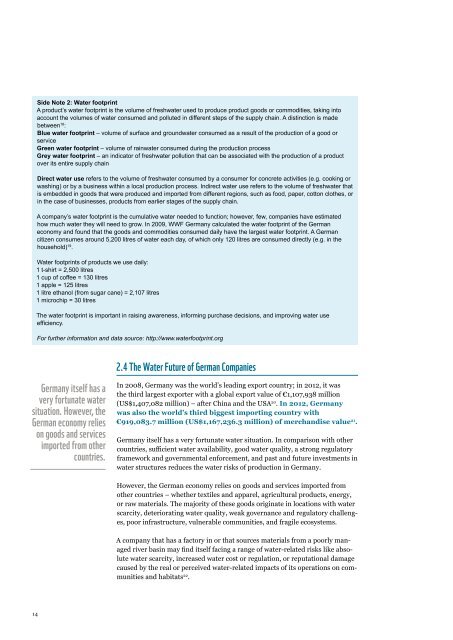YtDl2r
YtDl2r
YtDl2r
You also want an ePaper? Increase the reach of your titles
YUMPU automatically turns print PDFs into web optimized ePapers that Google loves.
Side Note 2: Water footprint<br />
A product’s water footprint is the volume of freshwater used to produce product goods or commodities, taking into<br />
account the volumes of water consumed and polluted in different steps of the supply chain. A distinction is made<br />
between 18 :<br />
Blue water footprint – volume of surface and groundwater consumed as a result of the production of a good or<br />
service<br />
Green water footprint – volume of rainwater consumed during the production process<br />
Grey water footprint – an indicator of freshwater pollution that can be associated with the production of a product<br />
over its entire supply chain<br />
Direct water use refers to the volume of freshwater consumed by a consumer for concrete activities (e.g. cooking or<br />
washing) or by a business within a local production process. Indirect water use refers to the volume of freshwater that<br />
is embedded in goods that were produced and imported from different regions, such as food, paper, cotton clothes, or<br />
in the case of businesses, products from earlier stages of the supply chain.<br />
A company’s water footprint is the cumulative water needed to function; however, few, companies have estimated<br />
how much water they will need to grow. In 2009, WWF Germany calculated the water footprint of the German<br />
economy and found that the goods and commodities consumed daily have the largest water footprint. A German<br />
citizen consumes around 5,200 litres of water each day, of which only 120 litres are consumed directly (e.g. in the<br />
household) 19 .<br />
Water footprints of products we use daily:<br />
1 t-shirt = 2,500 litres<br />
1 cup of coffee = 130 litres<br />
1 apple = 125 litres<br />
1 litre ethanol (from sugar cane) = 2,107 litres<br />
1 microchip = 30 litres<br />
The water footprint is important in raising awareness, informing purchase decisions, and improving water use<br />
efficiency.<br />
For further information and data source: http://www.waterfootprint.org<br />
2.4 The Water Future of German Companies<br />
Germany itself has a<br />
very fortunate water<br />
situation. However, the<br />
German economy relies<br />
on goods and services<br />
imported from other<br />
countries.<br />
In 2008, Germany was the world’s leading export country; in 2012, it was<br />
the third largest exporter with a global export value of €1,107,938 million<br />
(US$1,407,082 million) – after China and the USA 20 . In 2012, Germany<br />
was also the world’s third biggest importing country with<br />
€919,083.7 million (US$1,167,236.3 million) of merchandise value 21 .<br />
Germany itself has a very fortunate water situation. In comparison with other<br />
countries, sufficient water availability, good water quality, a strong regulatory<br />
framework and governmental enforcement, and past and future investments in<br />
water structures reduces the water risks of production in Germany.<br />
However, the German economy relies on goods and services imported from<br />
other countries – whether textiles and apparel, agricultural products, energy,<br />
or raw materials. The majority of these goods originate in locations with water<br />
scarcity, deteriorating water quality, weak governance and regulatory challenges,<br />
poor infrastructure, vulnerable communities, and fragile ecosystems.<br />
A company that has a factory in or that sources materials from a poorly managed<br />
river basin may find itself facing a range of water-related risks like absolute<br />
water scarcity, increased water cost or regulation, or reputational damage<br />
caused by the real or perceived water-related impacts of its operations on communities<br />
and habitats 22 .<br />
14


